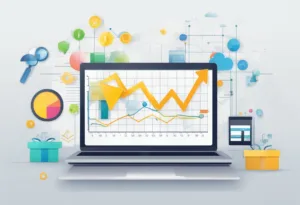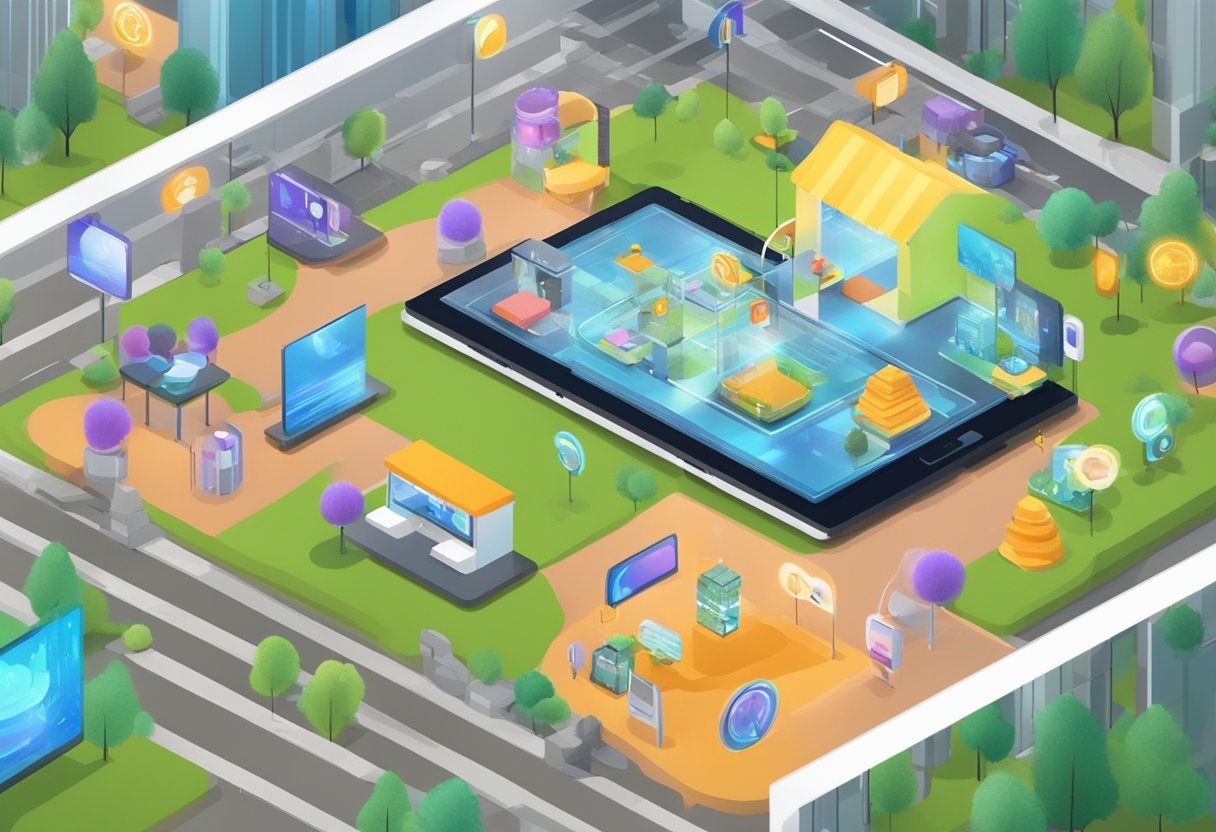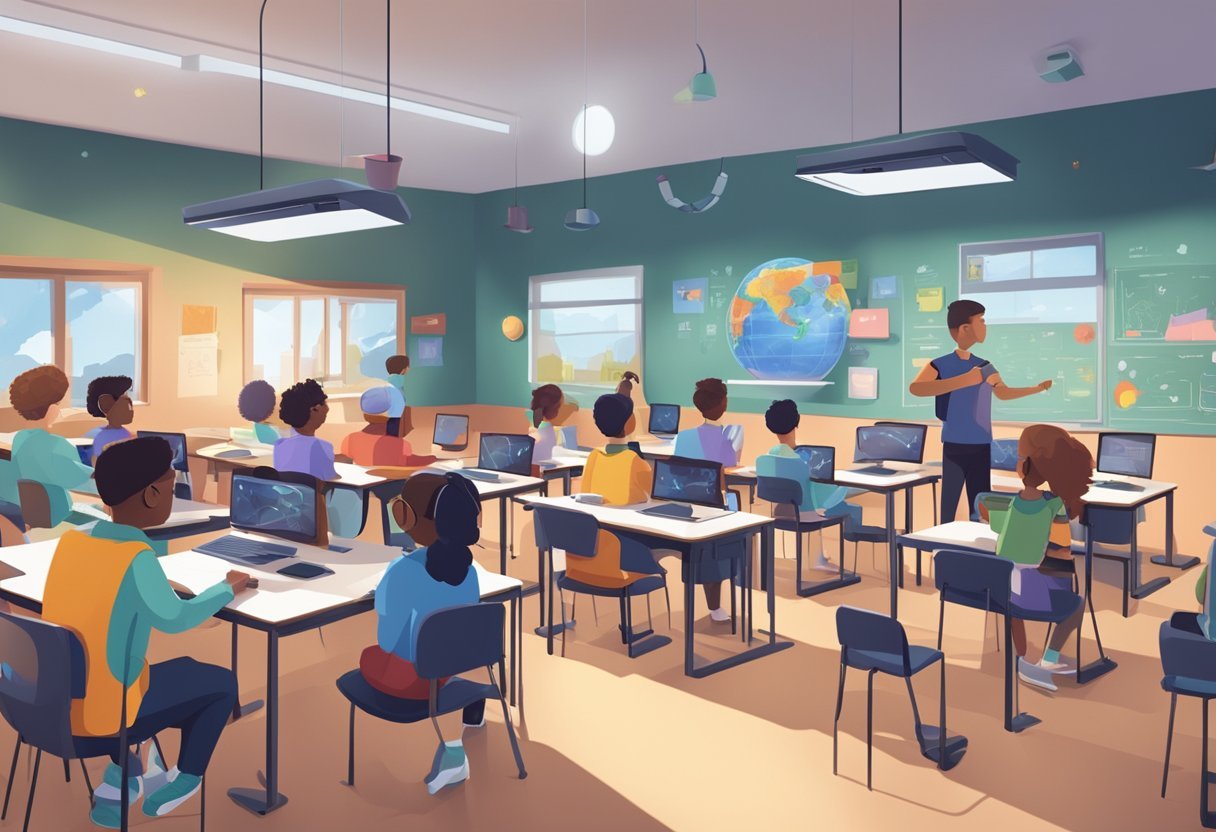Augmented reality (AR) is a rapidly growing technology that is changing the face of e-commerce. AR allows customers to interact with products in a more immersive way, making the online shopping experience more engaging and personalized. In this blog post, I will discuss AR for e-commerce and share with you 10 ways to use AR for e-commerce to boost your sales and customer experience.
AR works by superimposing digital content onto the real world, allowing customers to view products in a more realistic way. This technology can be used in a variety of ways, such as allowing customers to see how furniture would look in their home or how clothing would fit on their body. The rise of AR in e-commerce is having a significant impact on sales and marketing. With AR, businesses can create more engaging product demonstrations and marketing campaigns that capture customers‘ attention.
The Rise of AR in E-Commerce
As technology continues to advance, the use of augmented reality (AR) in e-commerce has become increasingly popular. AR technology is transforming the way consumers shop online, providing a more immersive and interactive experience. In this section, we will explore the role of AR in e-commerce and the various technologies used to implement it.
AR Technology used in E-commerce
AR technology has been around for some time, but it has only recently become more accessible to the general public. The technology is used to overlay digital information onto the real world, creating a more interactive experience. In e-commerce, AR technology is used to provide consumers with a more realistic view of products before they make a purchase.
One of the most common ways AR technology is used in e-commerce is through smartphone apps. By using a smartphone camera, consumers can see a 3D model of a product overlaid onto the real world. This allows consumers to see how a product would look in their home or how it would fit into their lives before they make a purchase.
Role of AR in E-commerce
The COVID-19 pandemic has accelerated the adoption of AR technology in e-commerce. With many consumers hesitant to visit physical stores, retailers have had to find new ways to reach consumers. AR technology has provided a solution, allowing retailers to create virtual try-on experiences for customers.
AR technology has also allowed retailers to create more engaging and interactive shopping experiences. By using AR technology, retailers can create virtual showrooms, allowing consumers to browse products in a more immersive way. This has the potential to increase consumer engagement and drive sales.
Innovation and technology continue to drive the adoption of AR in e-commerce. As the technology becomes more advanced and accessible, we can expect to see even more innovative uses of AR in the world of e-commerce.
10 Ways To Use AR For E-Commerce
Here are 10 ways augmented reality can boost your eCommerce business:
- Virtual Try-On Solutions
- AR-Powered Visualization Tools
- Interactive User Manuals
- Live AR Shopping Assistance
- AR-Enabled Store Navigation
- Social Media Integration
- Gamified Shopping Experiences
- Real-Time Product Customization
- In-Store Promotion with AR
- Post-Purchase AR Support
Virtual Try-On Solutions
Virtual try-on solutions are a prominent feature of augmented reality in eCommerce. These solutions allow customers to see themselves wearing or using a product without physically trying it on. For example, in the fashion industry, AR technology can overlay clothing items onto a customer’s live image, enabling them to gauge the look and fit of garments. In the eyewear sector, users can see how different glasses frames would look on their faces. This interactive experience not only increases customer engagement but also helps in reducing the likelihood of returns and exchanges, as customers have a better idea of what they are purchasing.
AR-Powered Visualization Tools
AR-powered visualization tools enable customers to view products in their intended environment before buying. For instance, furniture retailers use AR to allow customers to place a virtual piece of furniture in their own home to see if it fits the desired space and matches the decor. This immersive technology helps eliminate the guesswork associated with online shopping for spatially dependent items and contributes to a more confident purchasing decision, enhancing customer satisfaction and reducing return rates.
Interactive User Manuals
Augmented reality can transform traditional user manuals into interactive, three-dimensional guides. Customers can use their smartphone or tablet to scan an item, and the AR app overlays digital instructions directly onto the product. This can include animations illustrating assembly, operation, or troubleshooting steps. Interactive user manuals simplify the customer’s understanding and interaction with the product, leading to a more positive user experience and potentially reducing the number of customer service inquiries.
Live AR Shopping Assistance
Live AR shopping assistance combines the convenience of online shopping with the personalized service of in-store experiences. Customers can receive real-time help from virtual assistants or customer service representatives within an AR environment. For example, a customer considering a home appliance could see how it works and ask questions directly within the AR experience. This level of interactive customer service can increase customer confidence and enhance the overall shopping experience.
AR-Enabled Store Navigation
In physical retail environments, AR can enhance the shopping experience by providing virtual store navigation. Customers can use their smartphones to access AR maps that guide them through the store, pointing out product locations and providing detailed information with just a tap or scan. This can make shopping more efficient, enjoyable, and informative, offering a level of convenience that is akin to shopping online.
Social Media Integration
Social media platforms have embraced AR, providing eCommerce brands with new avenues to reach and engage customers. AR filters and lenses can be used in social media campaigns, allowing users to virtually try on products or interact with brands in an immersive way. This integration not only drives engagement but also encourages users to share their experiences with their networks, increasing brand visibility and potentially driving sales.
Gamified Shopping Experiences
Augmented reality can gamify the shopping experience, making it more engaging and entertaining for customers. By incorporating game-like elements into the shopping process, retailers can incentivize customers to explore products, participate in challenges, or unlock rewards. This gamification can lead to increased customer interaction with the brand and products, fostering loyalty and potentially boosting sales.
Real-Time Product Customization
AR allows customers to customize products in real-time and instantly visualize the results. This is particularly useful for products that come in various configurations, colors, or designs. Customers can make changes and see how these customizations look immediately, which not only enhances the shopping experience but also gives them a sense of ownership and satisfaction with the personalized product.
In-Store Promotion with AR
Augmented reality can be used for in-store promotions, providing customers with an interactive and informative layer on top of the physical shopping environment. Retailers can deploy AR-enabled signage or displays that customers can scan to access exclusive content, deals, or product information. This approach can make promotions more engaging and memorable, encouraging customers to take advantage of offers and increasing the effectiveness of promotional campaigns.
Post-Purchase AR Support
After a purchase, augmented reality can continue to enhance the customer experience through post-purchase support. AR can be used to provide assembly instructions, maintenance tips, or even suggest complementary products. This ongoing support can increase customer satisfaction and loyalty, as well as reduce the likelihood of returns by ensuring customers are able to fully utilize and enjoy their purchases.
How Does AR Work in E-commerce
Augmented Reality (AR) is a technology that superimposes digital information onto the real world. In e-commerce, AR allows customers to visualize products in a more interactive and immersive way, providing a more engaging shopping experience.
AR works by using a camera and a screen to overlay digital information onto the real world. The camera captures an image of the real world and sends it to the AR software, which then analyzes the image and identifies any objects that are present. The software then superimposes digital information onto the real world image and displays it on the screen.
There are two main types of AR used in e-commerce: marker-based AR and markerless AR. Marker-based AR uses a physical marker, such as a QR code or image, to trigger the AR experience. When the camera detects the marker, the AR software overlays digital information onto the marker. Markerless AR, on the other hand, uses computer vision technology to identify objects in the real world and superimpose digital information onto them.
AR in e-commerce has numerous benefits, including increased customer engagement, higher conversion rates, and reduced product returns. By allowing customers to interact with products in a more immersive way, AR helps them make more informed purchasing decisions and reduces the likelihood of returns.
AR technology is transforming the way e-commerce operates by providing customers with a more interactive and engaging shopping experience. As AR technology continues to evolve, it is expected to become an increasingly important tool for e-commerce businesses looking to stay competitive in the digital marketplace.
Improving Customer Experience with AR

Augmented Reality (AR) is transforming the way customers interact with products online, and retailers are beginning to take notice. By leveraging AR technology, businesses can offer their customers an immersive and interactive experience that can help improve customer satisfaction and drive sales.
Virtual Try-On and Visualization
One of the most significant benefits of AR for e-commerce is the ability to offer virtual try-on and visualization. With AR, customers can try on clothes, accessories, and even makeup virtually, eliminating the need to visit a physical store. This feature is especially useful for customers who live in remote areas or have mobility issues.
AR also enables customers to visualize products in 3D, providing a more realistic representation of the product. This feature can help customers make more informed purchase decisions and reduce the likelihood of returns.
Interactive User Manuals and Guides
AR can also be used to provide interactive user manuals and guides for products. By scanning a product with their smartphone, customers can access a virtual user manual that provides step-by-step instructions on how to use the product. This feature can help reduce customer frustration and improve the overall customer experience.
Enhancing Online Shopping Experience
AR can help enhance the online shopping experience by providing a more immersive and interactive experience. For example, customers can use AR to visualize how a piece of furniture would look in their home or how a new paint color would look on their walls. This feature can help customers feel more confident in their purchase decisions and reduce the likelihood of returns.
AR is transforming the way customers interact with products online, and businesses that leverage this technology can improve customer satisfaction and drive sales. By offering virtual try-on and visualization, interactive user manuals and guides, and enhancing the online shopping experience, businesses can create a more immersive and interactive experience for their customers.
Role of AR in Sales and Marketing

Augmented reality (AR) has been shown to have a positive impact on sales and marketing in the e-commerce industry. In this section, we will discuss how AR can boost conversion rates, be used in marketing campaigns, and integrated with social media.
Boosting Conversion Rates
AR can significantly boost conversion rates for e-commerce brands. By allowing customers to virtually try on and test products, AR provides a unique and interactive shopping experience that can increase customer engagement and ultimately lead to more sales. According to DFS, the use of 3D and AR resulted in a 106% increase in revenue per visitor (RPV) amongst shoppers. BMW also reported that 25% of all openings of its AR app progress at least one step further in the sales funnel.
AR in Marketing Campaigns
AR can also be used as a powerful tool in marketing campaigns. By creating AR advertising that allows customers to interact with products in a virtual environment, e-commerce brands can generate excitement and buzz around their products. This can lead to increased brand awareness and ultimately drive more sales. For example, an international cosmetics retailer found that AR usage on their mobile app was associated with higher sales for brands that are less popular, products with narrower appeal, and products that are more expensive.
Social Media Integration
AR can also be integrated with social media platforms like Instagram and Facebook. By creating AR filters and effects that allow users to interact with products in a fun and engaging way, e-commerce brands can increase brand awareness and drive more sales. For example, Sephora created an AR filter that allowed users to virtually try on makeup products and share the results on social media. This resulted in increased brand awareness and ultimately led to more sales.
AR Applications in Different Industries
Augmented Reality (AR) has been a game-changer for many industries, especially when it comes to e-commerce. With AR technology, customers can now experience products in a more interactive and immersive way, which has led to increased customer satisfaction and sales. Here are a few examples of how AR is being used in different industries.
Fashion and Apparel
The fashion and apparel industry has been one of the early adopters of AR technology. With virtual try-ons, customers can now see how clothes and accessories look on them without having to physically try them on. This has not only improved the shopping experience but has also reduced the number of returns. Sephora, for example, has an AR feature on its app that allows customers to virtually try on makeup products before purchasing them.
Furniture and Home Decor
AR technology has also made its way into the furniture and home decor industry. With AR-enabled apps, customers can now see how furniture pieces would look in their homes before making a purchase. This has made it easier for customers to visualize how a product would fit in their space and has reduced the number of returns. Many direct-to-consumer (DTC) furniture companies use AR technology to provide a better shopping experience for their customers.
Beauty and Cosmetics
AR technology has revolutionized the beauty and cosmetics industry. With AR-enabled apps, customers can now try on makeup virtually and see how it would look on them before making a purchase. This has not only improved the shopping experience but has also led to increased sales. Many retailers, such as Sephora, use AR technology to provide a more personalized and immersive shopping experience for their customers.
AR technology has been a game-changer for many industries, especially when it comes to e-commerce. With virtual try-ons and AR-enabled apps, customers can now experience products in a more interactive and immersive way, which has led to increased customer satisfaction and sales.
Challenges and Considerations
When it comes to implementing AR in e-commerce, there are several challenges and considerations that businesses need to address. Here are some important factors to keep in mind:
Technology and Hardware Limitations
AR requires a certain level of hardware and software capabilities to function properly. This can be a challenge for businesses that lack the necessary resources to invest in the required technology. Not all customers may have the hardware needed to experience AR, which can limit the reach of AR-enabled e-commerce platforms.
Balancing Immersion and Practicality
AR experiences can be highly immersive, but it’s important to balance that with practicality. If the AR experience is too complex or difficult to use, it can create friction for customers and discourage them from making a purchase. On the other hand, if the AR experience is too simplistic, it may not provide enough value to customers to justify the investment.
Privacy and Trust Concerns
AR-enabled e-commerce platforms may collect data about customers, which can raise privacy concerns. Businesses need to be transparent about what data is being collected and how it will be used. Customers need to trust that their data is being handled responsibly, which can be a challenge in a competitive e-commerce landscape.
Businesses need to carefully consider the costs and benefits of implementing AR in e-commerce. While AR can enhance the shopping experience and drive sales, it also comes with challenges and limitations that need to be addressed. By being strategic and thoughtful in their approach, businesses can successfully integrate AR into their e-commerce platforms and provide customers with a truly innovative shopping experience.
Frequently Asked Questions
How can AR be used in e-commerce?
AR can be used in e-commerce to enhance the customer experience by allowing them to virtually try on products before making a purchase. This can increase customer satisfaction and reduce the likelihood of returns. AR can also be used to create interactive product demonstrations, which can help customers better understand the features and benefits of a product.
Does AR really reduce e-commerce returns?
AR has the potential to reduce e-commerce returns by allowing customers to virtually try on products before making a purchase. This can help customers make more informed buying decisions and reduce the likelihood of returns due to sizing or fit issues. However, it is important to note that AR is not a magic solution and there may still be returns for other reasons.
What are the disadvantages of AR in e-commerce?
One of the main disadvantages of AR in e-commerce is the cost of implementing AR technology. It can be expensive to develop AR applications and integrate them into an e-commerce platform. Not all customers may have access to AR technology, which could limit the potential audience for AR-enabled products. Another potential disadvantage is the learning curve for customers who are not familiar with using AR technology.
How to use AR in digital marketing?
AR can be used in digital marketing to create interactive and engaging campaigns. For example, AR-enabled ads can allow customers to virtually try on products or visualize how a product would look in their home. AR can also be used to create immersive brand experiences, such as virtual showrooms or product demonstrations.
Is AR a digital marketing tool?
Yes, AR is a digital marketing tool that can be used to create engaging and interactive campaigns. AR can help brands stand out in a crowded digital landscape and create memorable experiences for customers. However, it is important to use AR in a way that aligns with your brand and resonates with your target audience.




